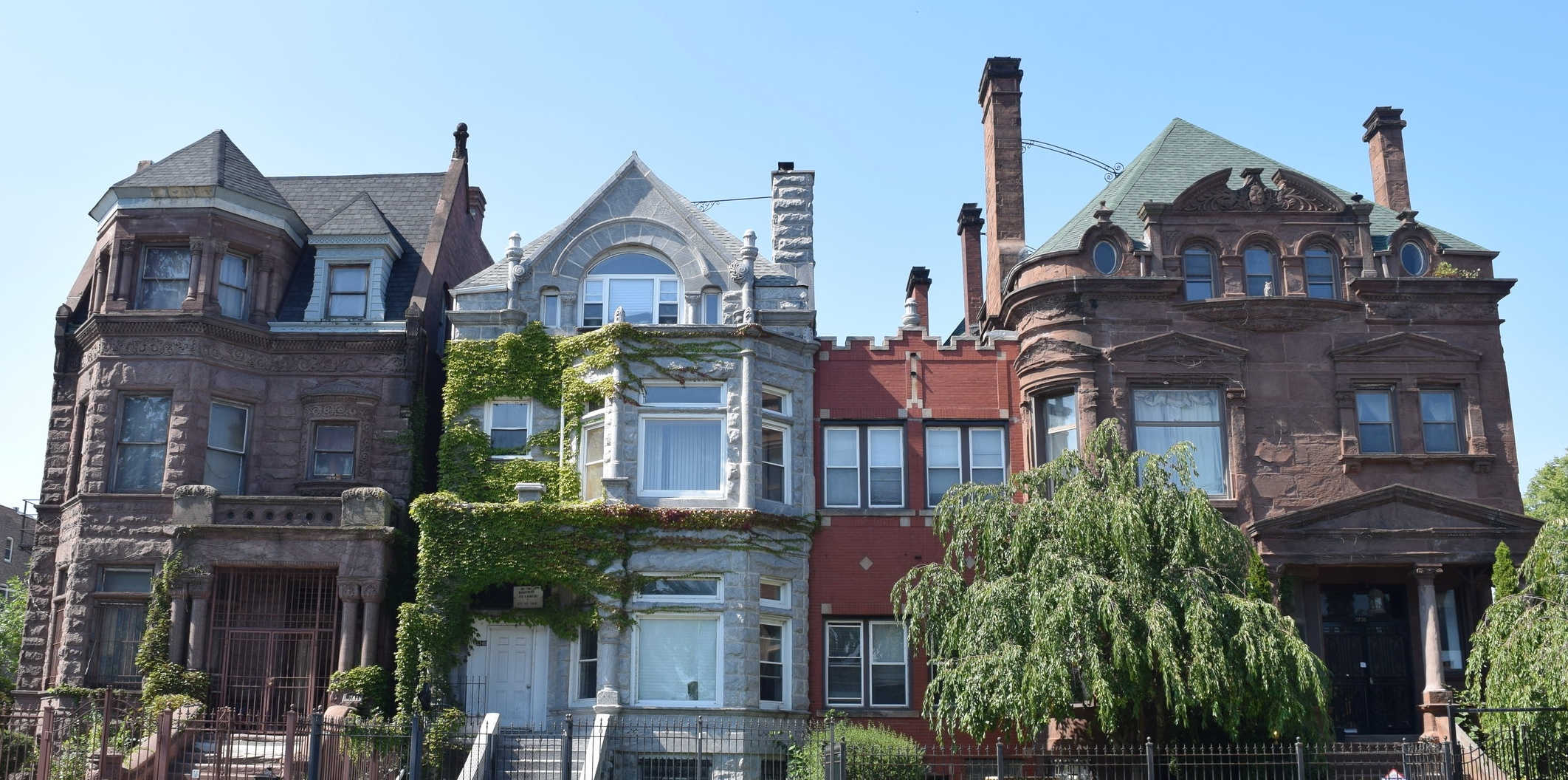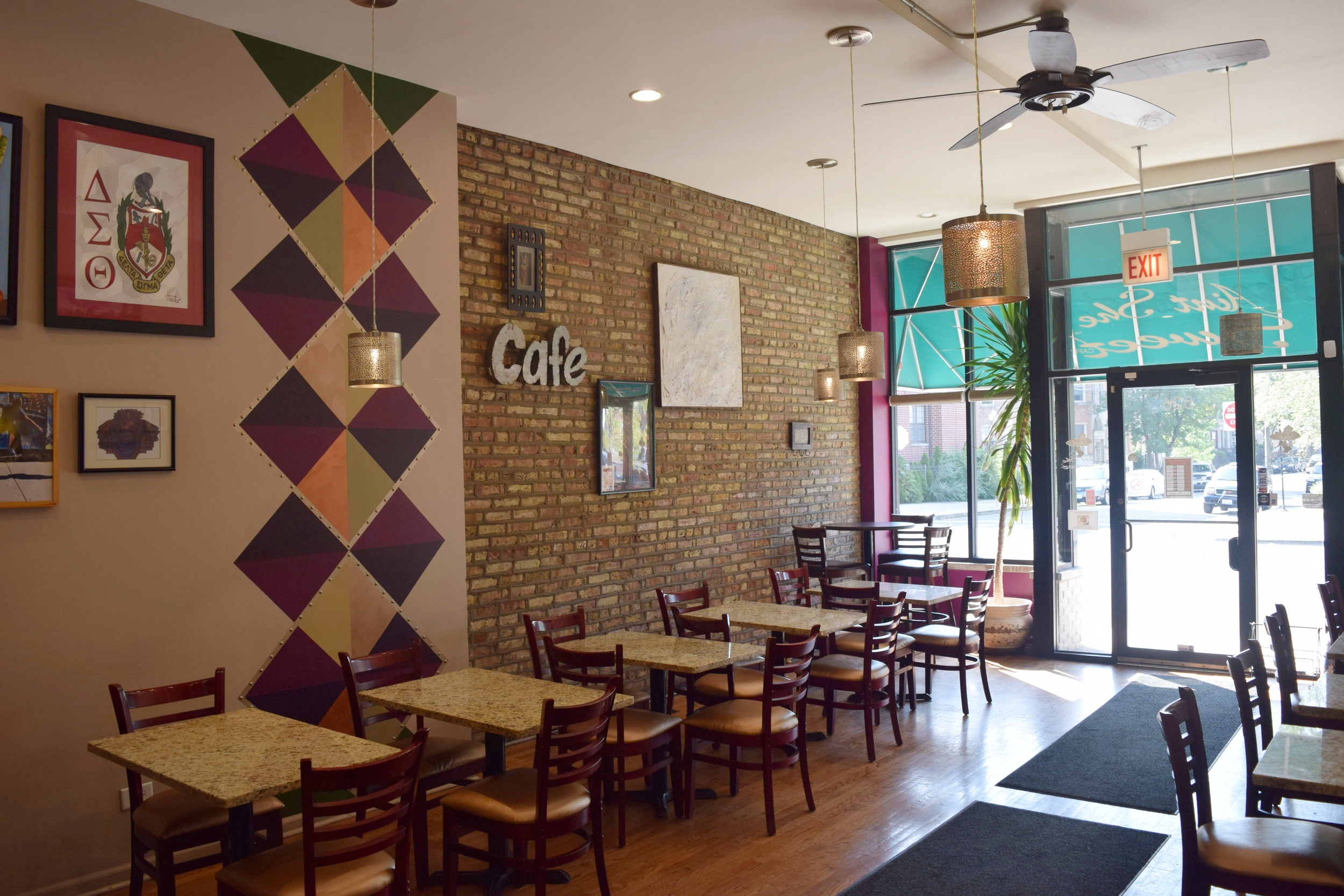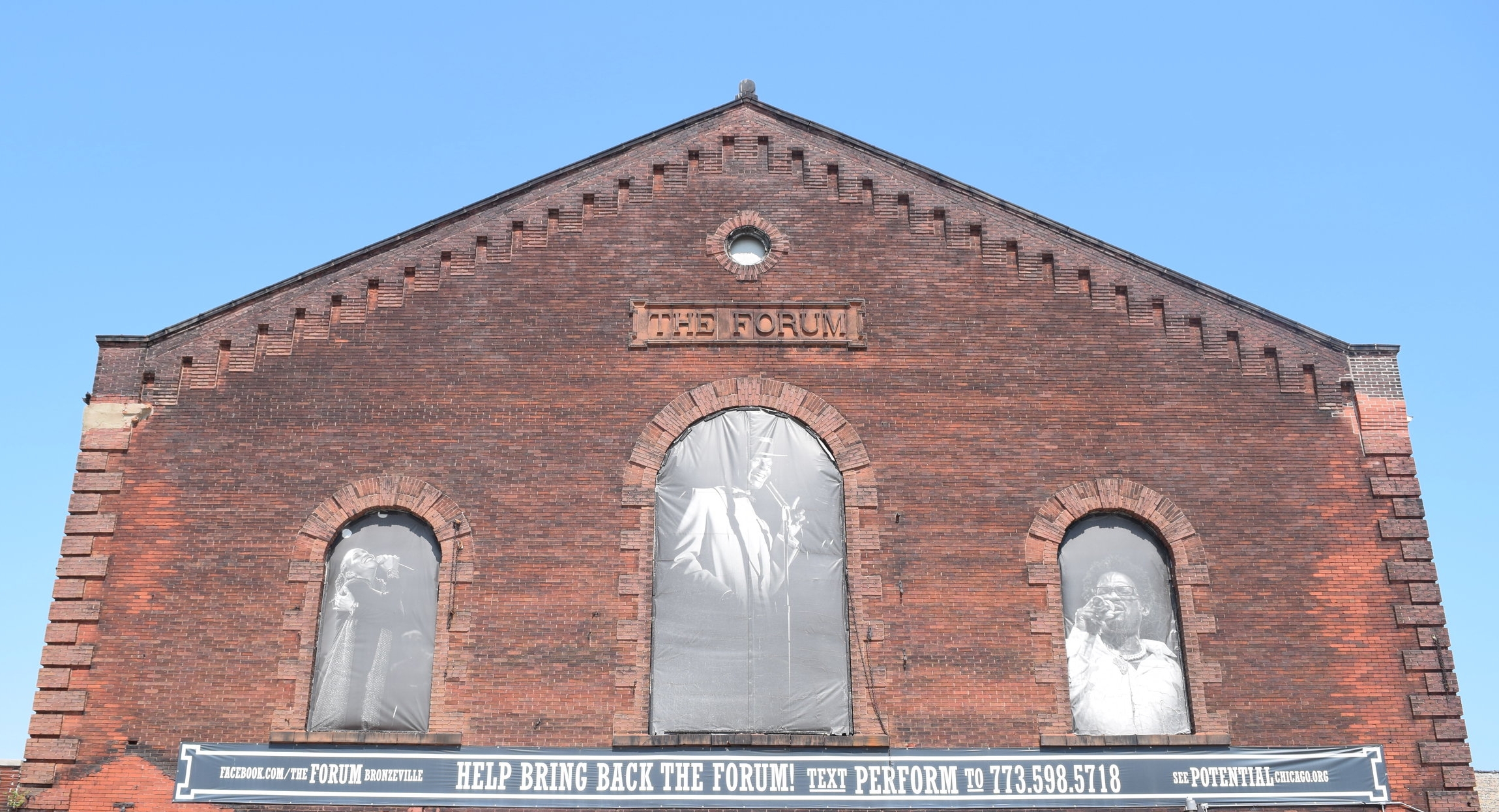BRONZEVILLE
Background
Douglas, the community area that encompasses Bronzeville’s northern half, began as the property and home of Abraham Lincoln’s debating foe and slavery defender, Stephen A. Douglas. During the Civil War, the North established Camp Douglas on the premises as a POW camp detaining Confederate soldiers. By the 1880s the area had developed into a well-to-do Jewish enclave. Further south in the Grand Boulevard section of Bronzeville, many of Chicago’s elite, including stock yard barons the Swifts’ and vaudeville stars the Marx brothers established stately homes along the lavish boulevards. It wasn’t until the 1890s that the neighborhood began to transform into an extension of the African-American community that had been residing in the Near South Side. The subsequent decades saw Bronzeville’s absorption of an enormous wave of migrants escaping the Jim Crow south. What became known as the “Black Metropolis” had its heyday from roughly the 1910s through the 1940s. Rivaling the Harlem Renaissance, Bronzeville became Chicago’s epicenter of Black working, middle, and upper-class culture and establishments. Black-owned newspapers, restaurants, clubs, theaters, and other businesses of “the city within a city” were found on and around State Street between 30th and 35th (“The Stroll”) and 43rd Street and 47th Street between State Street and Cottage Grove Avenue. Though Bronzeville suffered considerable decline during the Great Depression, Chicago’s imposed segregation, redlining, and racial housing covenants were even more devastating to the area in the post-war decades. Under urban renewal between 1941 and 1970, Chicago Housing Authority (CHA) projects were constructed such as the Ida B. Wells Homes, Stateway Gardens, and the Robert Taylor Homes. In the last three decades, coinciding with these public housing projects being torn down, the neighborhood has seen tangible revitalization, mostly as a result of an influx of many middle and upper-class African-American professionals. There’s also been a burgeoning appreciation for its collection of historic landmarks, architectural gems, engaging cultural institutions, and prized African-American owned businesses.
A Great Day in Bronzeville
Morning
A Bronzeville day can start bright and early with a visit to Abundance Bakery on 47th St. between Michigan and Indiana Avenue. Open since 1990, the neighborhood institution is a crowd pleaser for their apple fritters and old-fashioned doughnuts. Another casual Grand Boulevard option, the cavernous yet welcoming Sip and Savor on 43rd St. is a popular community hub serving up Colectivo coffee and a variety of pastries and light breakfast options. A second Bronzeville location is now also open in a renovated storefront in the Rosenwald Apartment building on 47th. In 2019, Douglas gained Emeche Cakery & Cafe, offering a range of pastries (with vegan options), breakfast sandwiches, and caffeinated beverages.
Sip and Savor
For a more robust morning meal, there’s Chicago’s Home of Chicken and Waffles. Though the pairing of chicken and waffles has Southern origins, its common lore that the unlikely combo emerged as a favorite of Harlem and Bronzeville jazz musicians craving both dinner and breakfast after finishing their 3:00 or 4:00 AM sets. In addition to the chicken and waffles varieties named after friends and family, there are plenty of soul and comfort standouts ranging from the catfish to fried chicken liver.
Right next door, another spot to grab breakfast and coffee is Little Sandwich House. The cafe has a selection of open-faced toast plates, coffee drinks crafted using Grandville, MI roaster Littlefoot Coffee, and smoothies.
Late morning is a great time to explore Bronzeville’s historic residential architecture. Remaining late 19th and early 20th century Italiante, Queen Anne, Romanesque, Classical Revival, and Flemish Revival attached row houses are dispersed throughout Douglas and Grand Boulevard. Designated historic districts include the Calumet-Giles Prairie District (aka “The Gap”, named due to its surviving the urban renewal projects that leveled adjacent blocks to make way for housing developments) on Calumet, Giles, and Prairie Avenues between 31st and 36th, the Giles-Calumet District on 3700 and 3800 blocks of Giles and 3800 block of Calumet Avenue, and the Washington Park Court District between 4900 and 4959 S. Washington Park Ct. On the 3200 block of Calumet Avenue, the Roloson Row Houses were Frank Lloyd Wright’s singular row house development and among his earliest commissions after leaving Louis Sullivan’s firm. Bronzeville’s main artery and one of Chicago’s most impressive boulevards, Martin Luther King Drive is replete with ornate 19th century greystone and brownstone mansions.
Roloson Row Houses
S. Martin Luther King Dr.
Many of the homes of Bronzeville’s most famous former residents are still standing. On South MLK Drive alone, there’s the former Romanesque greystone mansion (3624 S. King Dr.) of journalist, suffragist, and civil-rights advocate Ida B. Wells-Barnett, the first kitchenette apartment (4259 S. King Dr.) of poet, author and first African-American winner of a Pulitzer Gwendolyn Brooks, the three-story greystone (4512 S. King Dr.) of the Marx Brothers, and brick mansion (4742 S. King Dr.) of Robert S. Abbott, founder and publisher of what was the country’s most prominent African-American newspaper, the Chicago Defender and the creator of the Bud Billiken Parade, the largest and oldest African-American parade in the U.S. The Chateauesque mansion at 3806 S. Michigan was the original site of the DuSable Museum of African-American History and home of its founder, the artist and activist Dr. Margaret Burroughs. In Grand Boulevard you can stroll by the former homes of Louis Armstrong at 421 E. 44th St., Nat King Cole at 4023 S. Vincennes Ave., Black Boy and Native Son author Richard Wright at 4831 S. Vincennes Ave., and Dr. Daniel Hale Williams (445 E. 42nd St.), who was the first doctor to successfully perform an open heart surgery and founder of the first non-segregated hospital in the U.S. At 4648 S. Michigan Ave. the recently restored Rosenwald Apartments were once home to boxer Joe Louis, Gwendolyn Brooks, Nat King Cole, and a young Quincy Jones.
Ida B. Wells-Barnett House
Tyson Apartments, formerly Belmonte Flats, aka "The Kitchenette Building"
Louis Armstong's home
Rosenwald Apartments
Afternoon
Though recognized as one of Bronzeville’s best breakfast spots, grabbing lunch at Peach’s Restaurant is also a good option. Since opening in 2015, the bright and welcoming diner has been a neighborhood favorite for its strong Southern-soul-diner cuisine. Popular items include the salmon croquettes with cheese grits, the catfish, duck bacon, and their peach flavored house blend coffee.
As one of a few remaining mainstays to sample classic Chicago BBQ, Honey 1 BBQ is well worth a visit. Over the years the restaurant has relocated from Austin to Bucktown and then to Grand Boulevard, where it’s found a receptive home. A steady stream of patrons drop in for the hot links, tips, ribs, and smoked chicken slow-cooked on oak wood in a glass aquarium-style smoker.
If you’re looking for a slightly lighter meal, Ain’t She Sweet Café is probably your best bet. The quaint, but bustling eatery serves up wholesome sandwiches, wraps, salads, and smoothies. Evident of its growing popularity, a second location opened in Beverly in 2016, and a third location is in the works for Woodlawn in 2018. Increasingly gaining a higher profile, in a recent promotional video, the Obama Foundation celebrated the café’s role as an important neighborhood anchor.
Ain't She Sweet Cafe
At the far eastern commercial space of the Rosenwald Apartments on 47th, Shawn Michelle’s has become the go-to spot for homemade ice cream. While offering a wide range of dairy and vegan flavors, the shop also has more substantial desserts like the lemon poundcake sundae and cobblers.
For many, engaging with Bronzeville’s remaining historic remnants is the main attraction. One notable surviving structure is the old Chicago Defender Building at 3435 S. Indiana Ave. The nationally circulated weekly newspaper was pivotal in promoting Chicago and other northern cities as “the promised land” for Southern Black migrants. Besides its role in the Great Migration, the Chicago Defender published the poetry of Gwendolyn Brooks and columns by Langston Hughes. At 3647 S. State St. is the former site of the Chicago Bee newspaper, founded by born slave and entrepreneur Anthony Overton. Constructed in 1929, the ornamental art-deco building was renovated and became a Chicago Public Library branch in 1996. Overton is most well-known for his prominent African-American cosmetics company headquartered down the street at the Overton Hygienic Building at 3619-3627 S. State St. Additional historic buildings are the Supreme Life Building (3501 S. King Dr.), which was home to the first Black-owned insurance company in the north and the Eighth Regiment Armory (3533 S. Giles Ave.), the first armory constructed for an African-American military regiment in the U.S.
Chicago Bee Building
A handful of Bronzeville’s famed musical brick and mortar landmarks have also survived. The Sunset Café at 315 E. 35th St., which later became the Grand Terrace Café, was one of the most pivotal clubs in jazz history. It was here that residents King Oliver, Louis Armstrong, Cab Calloway, and Earl “Fatha” Hines, as well as orchestra members Dizzy Gillespie, Charlie Parker, and Nat “King” Cole were regular performers and received major exposure. At 43rd and Calumet, The Forum was a former dance hall, jazz and blues mainstay, and community gathering space. In 2011, the Bronzeville development focused non-profit Urban Juncture took ownership of the 1897 building to stave off a city demolition order.
The Forum
Gospel music grew out of two converted Bronzeville synagogues. Thomas A. Dorsey began developing the gospel sound as a piano player at Ebenezer Baptist Church (4501 S. Vincennes Ave.) and brought it to prominence as musical director at Pilgrim Baptist Church (3300 S. Indiana Ave.). While the beautiful Classical Revival interior has been preserved at Ebenezer Baptist Church, only the brick and stone walls survived a 2006 fire at Pilgrim Baptist Church. Contingent on reaching ambitious fundraising goals, Pilgrim may see new life as the National Gospel Museum in the next decade.
At 3806 S. Michigan Ave., the South Side Community Art Center is a living testament to Bronzeville’s enduring arts prowess. Founded in 1940 and formally dedicated by Eleanor Roosevelt in 1941, the multidisciplinary center is notable for developing and supporting the work of acclaimed artists ranging from painters Charles White and Archibald Motley Jr., painter and printmaker Eldzier Cortor, photographer and film director Gordon Parks, poet and author Gwendolyn Brooks, and visual artist, poet, educator, and founding member Dr. Margaret Burroughs. Distinguished as the oldest remaining African-American art center in the U.S. and only remaining arts institution created under the Works Progress Administration, the center was recently designated a National Treasure by the National Trust for Historic Preservation.
South Side Community Art Center
Nestled in several Douglas and Grand Boulevard blocks are exceptional public art gems. Chief among them are the surviving murals of Chicago’s Black Art Movement. Inspired by the cultural impact of 1967’s “The Wall of Respect” at 43rd and Langley (torn down in 1971), master Chicago muralists depicted images of community pride and social injustice on walls scattered throughout the South Side. Preserved works by some the movement’s most well known muralists include “History of the Packinghouse Worker” (William Walker, 1974) at 4859 S. Wabash Ave., “The Wall of Daydreaming and Man’s Inhumanity to Man” (Mitchell Caton and William Walker with poem by Siddha Webber, 1975 – restored 2013) at 47th and Calumet Ave., “Black Women Emerging” (Justine DeVan, 1977) at 41st and S. Cottage Grove Ave., “The Earth is Not our Home” (Siddha Webber, 1981 – restored 2013) on the west side of 40th and MLK Dr., “Have a Dream” (Siddha Webber, 1995 – restored 2014) on the east side of 40th and MLK Dr., and “Another Time’s Voice Remembers My Passion’s Humanity” (Mitchell Caton and Calvin Jones, 1979 – restored 1993) in the Donnelley Center Community Art Garden at 3947 S. Michigan Ave. Former Chicagoan and New Orleans based artist Marcus Akinlana added the now iconic “The Great Migration” mural to the Donnelley Center Community Art Garden in 1995. Recent noteworthy additions include murals (2016) found in the interior of the Mariano’s at 38th and King Dr. by the world-acclaimed artist, Hebru Brantley and an exterior mural celebrating the legacy of Afri-cobra and the AACM (Association for the Advancement of Creative Musicians), entitled “Color Me Southside” (Dorian Sylvain, 2019).
"The Earth Is Not Our Home"
"The Wall of Daydreaming and Man’s Inhumanity to Man"
Fittingly, there are multiple bronze sculpture pieces commemorating Bronzeville’s historic legacy on S. MLK Dr. in Douglas. At 26th Street Alison Saar’s “Monument to the Great Migration” (1994) portrays a man adorned in shoe soles heading northward. “The Victory Monument” (1927) by Leonard Crunelle at 35th St. honors an African-American regiment that served in France during WWI. Also in the median at 35th is artist Gregg LeFevre’s bronze map of the neighborhood’s historic sites. And distributed between 25th and 35th the Bronzeville Walk of Fame consists of 91 plaques celebrating influential neighborhood residents.
Building on Bronzeville’s ongoing appreciation of visual arts, Gallery Guichard is the neighborhood go-to to view contemporary work primarily focused on the African Diaspora. The 4,000-square-foot gallery has rotating exhibits every 6-8 weeks featuring works by local, national, and international artists. In addition to the gallery space, on the adjacent lot the “Migration Park” sculpture garden features a solar powered pyramid designed by Chicago artist Olusola Akintunde (aka Shala) with the help of local high school students. Situated at the corner of 47th St. and Vincennes Ave., the garden and pyramid adorned with hieroglyphic iconology are at the historic site of the legendary drinking institution, the Palm Tavern.
Migration Park
Like Gallery Guichard’s sculpture garden, Boxville is a growing, cutting-edge, placemaking destination. Now open 6 days a week from May to October on the lot east of the 51st Green Line Station, Boxville is an outdoor market harnessed by reused shipping containers. Core vendors of the Urban Juncture enterprise range from vegan eateries and custom apparel boutiques to a bike and skate repair shop and an onsite greenhouse. The Belgian frites stand Friistyle, one the longest running startup vendors, now has an attached brick and mortar spot around the corner. Additionally, the market hosts DJ sets, live music, and food demos.
Boxville
Perhaps Bronzeville’s most well-known functionally designed space is the Illinois Institute of Technology’s (IIT) campus. Though controversial for its role in urban renewal, leveling the heart of the “The Stroll”, IIT’s grounds showcase a wealth of modernist marvels: twenty Mies Van der Rohe designed buildings including the architectural exemplar Crown Hall, Dutch architect Rem Koolhaus’ striking one-story student hub and concrete and steel tube enclosure of the Green Line coined the McCormick Tribune Campus Center, and Helmut Jahn’s deviceful State Street Village residence halls. The most recently completed modernist campus landmark is the John Ronan Architects designed Ed Kaplan Family Institute, which features an eco-design and materials for utilizing solar-power and maximizing energy efficiency.
Crown Hall
Bronzeville’s revamped recreational spaces also employ noteworthy design. The serpentine, $23 million 35th Street Bridge leads pedestrians and bicyclists to the pristine Margaret T. Burroughs Beach and Park (31st St. Beach) and the placid Burnham Wildlife Corridor. A particularly beautiful stretch of trail heading south from 31st Beach winds through native prairie and woodlands to a hill overlook and the La Ronda Parakata sculpture. Created by artists Hector Duarte and Alfonso Nieves and commissioned by the Pilsen non-profit Casa Michoacán, the interlocking butterfly sculpture utilizes an apt migration motif.
35th Street Bridge
La Ronda Parakata
Completed in 2016, the Ellis Park Field House is a light filled building imbued with steel and precast concrete. The 30,000 sq. foot facility includes a gym, swimming pool, fitness room, and space for clubs. Eco-friendly features such as a green roof, rain garden, and a solar thermal system for hot water were incorporated in its construction.
Evening
Since relocating from Chatham in 2015, Yassa Restaurant has been Bronzeville’s spot for excellent West African cuisine. Popular Sengalese dishes include Tiebu Djen, tilapia cooked in a tomato sauce, Yassa, chicken, fish, lamb, or shrimp grilled and marinated with onion, garlic, mustard, and lemon, Dibi, lamb or chicken grilled with a mustard sauce marinade, and Maffe, a stew consisting of lamb cubes, potatoes, carrots, and yams in a peanut butter-tomato sauce. Also worth trying are the natural beverages made from bissap (a type of hibiscus), ginger, or baobab tree fruit pods.
Another great dinner option is Pearl’s Place. The southern-style, comfort food eatery has been serving Bronzeville for over 30 years. The steady breakfast and lunch crowds pick back up for dinner to indulge on dishes such as the fried green tomatoes, fried or jerk chicken, and catfish, which can be ordered off the menu or with the dinner buffet. A hearty meal can be topped off with Pearl’s distinguished sweet potato pie.
An engaging way to spend a Bronzeville evening is attending an opening or event at Blanc Gallery. In addition to various community focused art exhibits ranging from celebrating Obama’s presidency to The Great Migration, the gallery holds artist talks, panel discussions, and benefits for local non-profits.
Featured Organization
Since the mid-2000s, community development focused Urban Juncture has been working to bring better food options, commercial opportunities, and gathering spaces for Bronzeville. In addition to its Build Bronzeville iniatives Boxville market and restoration of The Forum, Urban Jucture projects include restaurant incubator Bronzeville Cookin’ featuring the Friistyle and a rooftop garden, the Bronzeville Incubator co-working space, and the Bronzeville Community Garden.



















